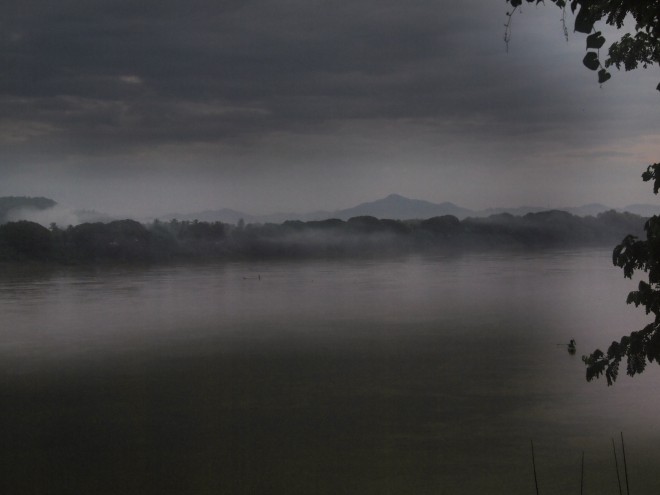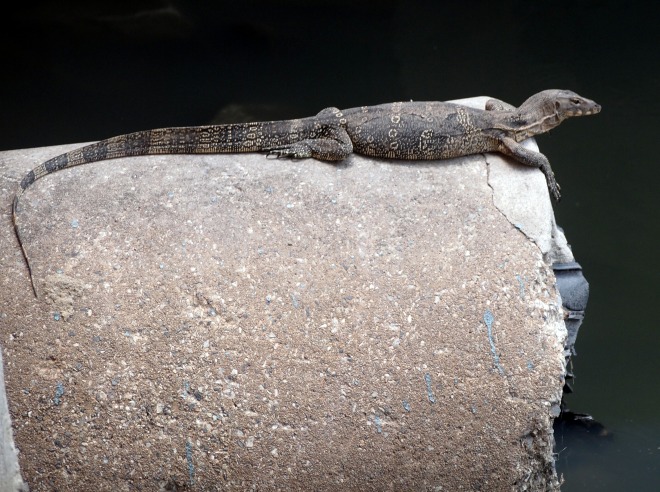One of the world’s great rivers, the Mekong, rises in the Tibetan Himalayas, flows through China, provides a border between Myanmar and Laos, then Laos and Thailand, before journeying through Cambodia and Vietnam to the sea.
The 196 kilometre road journey from Nong Khai to Chiang Khan in northern Thailand keeps the river in sight for most of the trip, and Laos across the water. Travel guides rightly describe this as one of the most scenic trips in Thailand. As a drive of about 4 hours without stops, it’s an easy day trip allowing for local sights.
My journey began at Nong Khai, a small riverside city that has hosts a lively river trade, and the Friendship Bridge between Thailand and Laos, the closest border crossing to Vientiane, the Lao capital, about 25 kilometres north-west.
Sometimes the river valley is a few kilometres wide, while at others times forested hills plunge straight into the river. The journey offers beautiful river scenery, the varying moods of the river itself, running wide and deep, or more treacherously through rapids, islands and shallower water, bordered by fertile productive agriculture of seemingly endless mixed uses, the opposite of monoculture – rice paddies, coconut palms, fields of pineapples, many varieties of vegetables, banana palms, papayas, ponds for fish – along with sections of lush rainforest.
There are other attractions: important and historic forest wats (Buddhist temples), riverside villages and towns far removed from urban Thailand, a waterfall in the rainforest, and the often surprising and varied sights of rural life.
Impressively along the way, there are kilometres of paved and fenced riverside walks for local use, even in tiny villages, a reminder yet again how many ‘poorer’ countries focus on improvements for the whole population as many wealthier first world countries limit access to those who can pay.
Laos always lies on the other side of the river, sometimes appearing prominently like the riverside buildings of Vientiane, but more usually in a less populated and wilder form than the Thai side.
Chiang Khan is proudly re-inventing itself, a town of 5000 or 6000 residents stretched along the river. Most old teak wooden houses and shophouses have been restored and renovated, and tourism has brought increased wealth. The style is retro chic. The bicycle is a popular form of transport and a town motif.
 As a visitor who prefers that tourism does not cause a locality to overly pander to us and ultimately lose its identity, to me Chiang Khan is doing well. I have seen enough beautiful localities transformed into false and inauthentic playgrounds for short-term visitors, be they the Costa Brava in Spain, or some of the beaches and islands in Asia.
As a visitor who prefers that tourism does not cause a locality to overly pander to us and ultimately lose its identity, to me Chiang Khan is doing well. I have seen enough beautiful localities transformed into false and inauthentic playgrounds for short-term visitors, be they the Costa Brava in Spain, or some of the beaches and islands in Asia.
Chiang Khan currently has the advantage of being a destination mainly for Thais. I only noticed about 4 or 5 other farang (foreigners/Europeans) on my five-day visit, and certainly, signage, menus, the absence of western food and other indicators suggest the absence of a western invasion, hopefully to remain so.
Once in Chiang Khan, if you rise at 6am, it will still be hot (27 degrees celsius when I checked) and there is an opportunity to see monks receiving alms in the street over the next hour or so, as well as to view the river emerging through the morning mist.

Later in the day a relaxing stroll is in order after watching the fishermen negotiate the river currents, At night, particularly on weekends when Bangkok visitors arrive, things get busier. Join the promenade to sample the sights: street food everywhere, musicians playing traditional Isan (northern Thai) music as well as modern styles, girls in tribal outfits dancing in the street, cyclists and strollers enjoying the festive atmosphere, eating, drinking ….
Sunset is best seen next to the river as a few small fishing boats return home.

Practicalities
Travel Options
Car rental from Udon Thani (1 hour south of Nong Khai) is quite reasonable. Avis quoted TBT560 (about AU$22) per day plus insurance excess cover for a small automatic gearbox car.
Driving yourself might be a reasonable option, noting that Thais drive on the left. Once away from the bigger city centres, Nong Khai and Udon Thani, traffic is quite light. Most major traffic signs are in Thai and English. However, some of the sights off the road are only signposted in Thai. Also, parking could become an issue.
I opted for a car and driver. I recommend Mr Chang from Nong Khai (Phone 081-369787) whom I contacted through Mut Mee Garden Guesthouse. He is relaxed and pleasant, and drove safely and reasonably; an important attribute to me as I have had more than my share of suicidal Thai drivers whose main mission in life is to speed excessively and always opt to pass on the most dangerous corners and crests. We agreed on TBT3000 (AU$115 or US$81) for the day.
The car and driver option makes the journey more flexible and independent, while it does mean missing out on some of the experiences, positive and negative, of public transport in remoter parts of a foreign country.
A hired motorcycle an option.
Boat travel is not available, presumably because some of the river along this stretch is not navigable.
Bus connections are available, but there is no single bus trip connecting Nong Khai with Chiang Khan. I decided that it would take too much time to be feasible in my circumstances.
Recommendations
Chiang Khan
Tonkong Guesthouse for basic inexpensive accommodation. TBT700 for a double per night (AU$28 or around US$19) with Air Con, breakfast and free WiFi. Own bathroom and toilet. Room 8 on the first floor is the best room with windows looking directly onto the river, and the room opens onto a guest terrace that also overlooks the river.
Located between Soi 2 & 3.
Nong Khai
Mut Mee Garden Guesthouse (mentioned in all the guidebooks) is a good budget choice with varying prices, TBT1400 (AU$56 or about US$38) for the best rooms (try Arun – Room A) – with Air Con, own bathroom and balcony overlooking the river. The best room is Arun (room A). The riverside restaurant is a good place to while away some time. Inform the cooks that you prefer spicy food if you prefer real Thai tastes.







